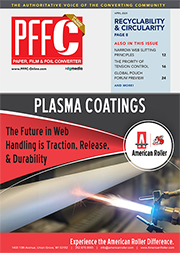Featured Stories
-
Tension: The First Thing We Must Get Right
Web tension is arguably the most important parameter for any web process. Tension is the first thing we must get right. -
Principles of Narrow Web Slitting
For those veterans in the slitting-winding community, this commentary is not necessarily new information, but reviews are always good too. -
Recyclability & Circularity Consumers Support Sustainable Brand Packaging
Sustainability has never been more central for the printing and packaging industries.
News | New Products
-
BioEmitter®- Keeping Corrosion and Rust at Bay in Enclosed Spaces
One of the most important missions of Cortec® Corporation, a global leader in the corrosion protection industry, is environmental responsibility.
-
Fedrigoni Names New Commercial Senior Vice President, Chief Marketing Officer
Fedrigoni — the world’s leading manufacturer of specialty papers, premium self-adhesive materials, RFID and connected solutions
-
SEI Laser Converting chooses Vetaphone for surface treatment
SEI Laser Converting is based in Buja in the northeast corner of Italy.
-
Former Division of the Knox Woolen Mill in Camden Acquired
Edward H. Best Company has been acquired by Windward Ventures LLC, a Maine-based investment group.
-
Miraclon and BOBST reinforce strategic partnership
Miraclon and BOBST have reinforced their strategic partnership, with Miraclon named as the plate technology partner in BOBST’s new Competence Center in Atlanta.
-
Anderson & Vreeland announces the expanded role of Tyler Thomas as National Sales Manager - U.S.
Anderson & Vreeland, a prominent manufacturer and distributor of flexographic print technologies, equipment, and consumables, is pleased to announce the expanded role of Tyler Thomas as National Sales Manager - U.S.
-
Valve Actuators with Longer Lifespan
QTRCO has innovated actuator designs specifically for high cycle, high speed, high reliability applications
Expert Advice
Automatic Roll Change
- Published: August 15, 2006, By By Sharad Shah, Kusters Calico Machinery Ltd.
Web Exclusive
Large converting machines may have as many as two or more unwinds besides the rewind. In such a machine, the operator will be kept quite busy just changing rolls, if operator intervention is required to initiate turret rotation and final splicing at the right moment, and will have little or no time to monitor the process. Ideally the operator should only have to load a new roll in place of the expired roll (or unload the finished roll from the rewinder and load an empty core), and the controls should do the rest.
For rewinds, one may want to start a new roll when the diameter has reached a set value, or when the roll has wound a set length of material, or whenever a new roll is started at the main unwind. Splice timing at the rewind is not critical, and an error in timing will not result in a failed splice.
For unwinds, one wants to change the roll when the material left on the expiring roll is as little as possible. This is done by entering the core diameter as data. But all cores are not the same diameter, and in order to ensure there is no missed splice, the actual splice will have to be programmed at the largest core diameter likely to be encountered. If turret rotation is to be initiated 1 min before splice, the rotation must start when the balance length is equal to line speed.
If a waste of 10 m is allowed, the splice must take place when the balance length is 10 m. The line speed is always known, but to know the balance length at any time, one needs to know the material thickness.
The material thickness often can be entered as one more piece of data whenever a new roll is started. But what if this is not done? The programmable logic control (PLC) system can calculate this after a short delay. After a new roll is started and tension control is taken over by diameter calculator, the current diameter is stored and a rotation counter is enabled. The rotation counter signal may come from a proximity switch on the winder shaft, which is often provided for glue line detection, or it can come from the encoder on the unwinder motor after scaling for PPR (pulse per rotation) of the encoder and mechanical step down.
When the unwind roll diameter has gone down by 200 mm, the rotation counter is read and the material thickness is calculated as 200/2n where n is the count of the rotation counter after the diameter is reduced by 200 mm. For example, if n=1,000, the material thickness is 0.1 mm (100 µ), or if n=10,000, the material thickness is 0.01 mm (10 µ).
Once the thickness is known, the PLC can calculate the full batch length L, the balance length l, and balance time t as under:
| Th | Material Thickness | = | {1000X(D2-D1)}/2n | µ (microns) |
| L | Full Batch Length | = | {Ð(D22-d2)/(4XTh)} + n2 | m |
| I | Balance Length | = | L-N | m |
| t | Balance Time | = | I/V | min. |
where:
| V | = | Line Speed (mpm) |
| D | = | Full Batch Diameter (mm) |
| L | = | Full Batch Length (m) |
| d0 | = | Core Diameter (mm) |
| d | = | Roll Diameter of running roll after which next roll can be loaded |
| D2 | = | Diameter when Rotation Counter is enabled (mm) |
| D1 | = | Diameter when Rotation Counter read (D2-200) (mm) |
| n | = | Count in Rotation Counter when Batch Diameter is D1 |
| Th | = | Material Thickness (µ) |
| I | = | Balance Length (m) |
| t | = | Balance Time (min) when Balance Length = I |
| N | = | Production Count (m) |
| n2 | = | Production Count when Batch Diameter is D2 |
A few words of caution: Do not use the diameters read from an ultrasonic sensor for thickness calculation as it is not accurate enough. The diameter calculator is more accurate. The balance time must be updated using the current line speed. The calculations of thickness depend on the assumption that thickness is uniform throughout the batch length. If it is not so, the thickness calculation can be repeated every time the diameter is reduced by another 100 mm.
This is how the system will operate (see flow chart below). After splice, enable tension and diameter calculator. Wait for about a minute to allow the system to stabilize. Now save the current calculated batch diameter, and reset and enable the rotation counter. When the batch diameter is reduced by 200 mm, read the rotation counter (n) and calculate the material thickness Th as (200 X 1000)/ (2Xn) and the full batch length L ={ð (D22 – d2)/(4xTh)} + n2
Thereafter, the balance length l = (L-N) and balance time t=l/V are continuously updated using the current value of production counter (N) and line speed (V).
Most winders and unwinders do not allow loading of a full new roll until the running roll diameter is reduced to some diameter (d). In that case, when the running roll diameter is reduced to required diameter, loading of new roll will be enabled, and the operator will be prompted to load a new roll. The operator loads a new roll and enables automatic roll change. If this is not done before turret rotation is due, the machine will go into normal stop.
If automatic roll change is enabled, when the balance length is equal to line speed, the line speed is frozen and turret rotated. Next when balance length l is 10 meters, splice is executed.
The table below shows typical calculations for (1) Material Thickness of 10 ì and Line Speed of 100 m/min, and (2) Material Thickness 100 ì and Line Speed of 300 m/min.
Calculations for Turret Rotation Splice
|
V m/min |
100 |
300 |
DATA |
|
|
n |
10000 |
1000 |
|
|
|
D mm |
1000 |
1000 |
|
|
|
d0 mm |
82 |
82 |
|
|
|
D2 mm |
800 |
800 |
|
|
|
D1 mm |
600 |
600 |
|
|
|
Th microns |
10 |
100 |
CALCULATED |
|
|
L meters |
78372 |
7837 |
|
|
|
N meters |
78272 |
7537 |
TURRET |
|
|
l meters |
100.00 |
300.00 |
|
|
|
t sec. |
60 |
60 |
|
|
|
d mm |
85.9 |
198.5 |
|
|
|
N meters |
78362 |
7827 |
SPLICE |
|
|
l meters |
10 |
10 |
|
|
|
t sec |
6 |
2 |
|
|
|
d mm |
101.10 |
83.91 |
|
|
|
|
|
|
|
|
Follow this procedure to initiate turret rotation and splice at the right moment for any line speed and material thickness to ensure minimum waste due to material left on the expiring roll, even when material thickness is not entered as data. Experimenta la emoción de los nuevos casinos online casinos-online-nuevos.mx , donde la diversión nunca se detiene. Con una amplia selección de juegos y promociones, elige tu favorito y juega desde la comodidad de tu hogar. ¡Suerte garantizada!
Sharad Shah is a technical advisor to Kusters Calico Machinery Ltd., manufacturers of plasic film coating and laminating and textile wet processing machines in India. His special interest are unwinders and rewinders. He can be reached at This email address is being protected from spambots. You need JavaScript enabled to view it..
SUPPLIER INFO:
Kusters Calico Machinery Ltd.—kustercalico.com













